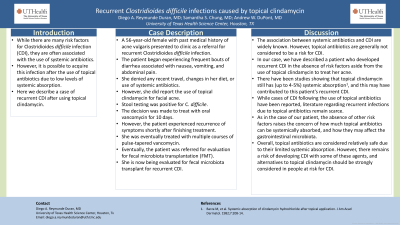Back


Poster Session E - Tuesday Afternoon
Category: Colon
E0108 - Recurrent Clostridioides difficile Infections Caused by Topical Clindamycin
Tuesday, October 25, 2022
3:00 PM – 5:00 PM ET
Location: Crown Ballroom

Has Audio

Diego A. Reymunde Duran, MD
University of Texas Health Science Center
Houston, TX
Presenting Author(s)
Diego A. Reymunde Duran, MD1, Samantha S. Chung, MD1, Andrew W. DuPont, MD2
1University of Texas Health Science Center, Houston, TX; 2University of Texas Houston Health Sciences Center, Houston, TX
Introduction: While there are many risk factors for Clostridioides difficile infection (CDI), they are often associated with the use of systemic antibiotics. However, it is possible to acquire this infection after the use of topical antibiotics due to low levels of systemic absorption. Here we describe a case of recurrent CDI after using topical clindamycin.
Case Description/Methods: A 56-year-old female with past medical history of acne vulgaris presented to clinic as a referral for recurrent Clostridioides difficile infection. The patient began experiencing frequent bouts of diarrhea associated with nausea, vomiting, and abdominal pain. She denied any recent travel, changes in her diet, or use of systemic antibiotics. However, she did report the use of topical clindamycin for facial acne. Stool testing was positive for C. difficile. The decision was made to treat with oral vancomycin for 10 days. However, the patient experienced recurrence of symptoms shortly after finishing treatment. She was eventually treated with multiple courses of pulse-tapered vancomycin. Eventually, the patient was referred for evaluation for fecal microbiota transplantation (FMT). She is now being evaluated for fecal microbiota transplant for recurrent CDI.
Discussion: The association between systemic antibiotics and CDI are widely known. However, topical antibiotics are generally not considered to be a risk for CDI. In our case, we have described a patient who developed recurrent CDI in the absence of risk factors aside from the use of topical clindamycin to treat her acne. There have been studies showing that topical clindamycin still has (up to 4-5%) systemic absorption1, and this may have contributed to this patient’s recurrent CDI. While cases of CDI following the use of topical antibiotics have been reported, literature regarding recurrent infections due to topical antibiotics remain scarce. As in the case of our patient, the absence of other risk factors raises the concern of how much topical antibiotics can be systemically absorbed, and how they may affect the gastrointestinal microbiota. Overall, topical antibiotics are considered relatively safe due to their limited systemic absorption. However, there remains a risk of developing CDI with some of these agents, and alternatives to topical clindamycin should be strongly considered in people at risk for CDI.
Disclosures:
Diego A. Reymunde Duran, MD1, Samantha S. Chung, MD1, Andrew W. DuPont, MD2. E0108 - Recurrent Clostridioides difficile Infections Caused by Topical Clindamycin, ACG 2022 Annual Scientific Meeting Abstracts. Charlotte, NC: American College of Gastroenterology.
1University of Texas Health Science Center, Houston, TX; 2University of Texas Houston Health Sciences Center, Houston, TX
Introduction: While there are many risk factors for Clostridioides difficile infection (CDI), they are often associated with the use of systemic antibiotics. However, it is possible to acquire this infection after the use of topical antibiotics due to low levels of systemic absorption. Here we describe a case of recurrent CDI after using topical clindamycin.
Case Description/Methods: A 56-year-old female with past medical history of acne vulgaris presented to clinic as a referral for recurrent Clostridioides difficile infection. The patient began experiencing frequent bouts of diarrhea associated with nausea, vomiting, and abdominal pain. She denied any recent travel, changes in her diet, or use of systemic antibiotics. However, she did report the use of topical clindamycin for facial acne. Stool testing was positive for C. difficile. The decision was made to treat with oral vancomycin for 10 days. However, the patient experienced recurrence of symptoms shortly after finishing treatment. She was eventually treated with multiple courses of pulse-tapered vancomycin. Eventually, the patient was referred for evaluation for fecal microbiota transplantation (FMT). She is now being evaluated for fecal microbiota transplant for recurrent CDI.
Discussion: The association between systemic antibiotics and CDI are widely known. However, topical antibiotics are generally not considered to be a risk for CDI. In our case, we have described a patient who developed recurrent CDI in the absence of risk factors aside from the use of topical clindamycin to treat her acne. There have been studies showing that topical clindamycin still has (up to 4-5%) systemic absorption1, and this may have contributed to this patient’s recurrent CDI. While cases of CDI following the use of topical antibiotics have been reported, literature regarding recurrent infections due to topical antibiotics remain scarce. As in the case of our patient, the absence of other risk factors raises the concern of how much topical antibiotics can be systemically absorbed, and how they may affect the gastrointestinal microbiota. Overall, topical antibiotics are considered relatively safe due to their limited systemic absorption. However, there remains a risk of developing CDI with some of these agents, and alternatives to topical clindamycin should be strongly considered in people at risk for CDI.
- Barza M, et al. Systemic absorption of clindamycin hydrochloride after topical application. J Am Acad Dermatol. 1982;7:208-14.
Disclosures:
Diego Reymunde Duran indicated no relevant financial relationships.
Samantha Chung indicated no relevant financial relationships.
Andrew DuPont indicated no relevant financial relationships.
Diego A. Reymunde Duran, MD1, Samantha S. Chung, MD1, Andrew W. DuPont, MD2. E0108 - Recurrent Clostridioides difficile Infections Caused by Topical Clindamycin, ACG 2022 Annual Scientific Meeting Abstracts. Charlotte, NC: American College of Gastroenterology.
